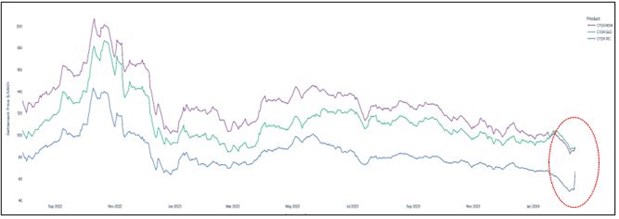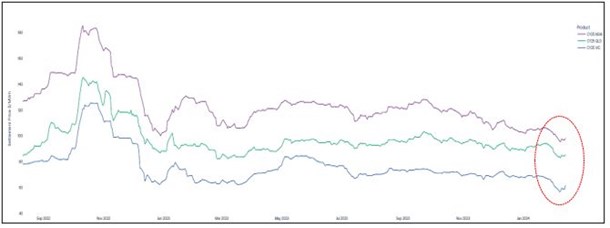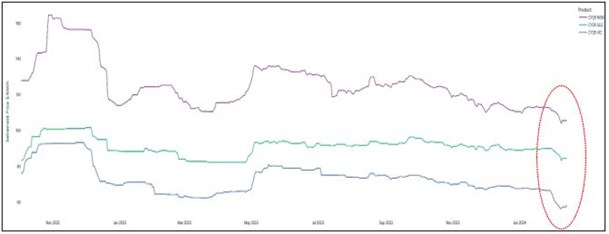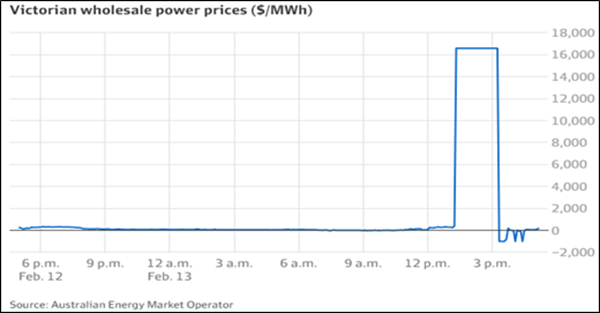Victoria hit by major power outage: Transmission failures and soaring spot prices
An Australian National Energy Market update by Scott Easton, Pricing and Retail Trading Manager, SmartestEnergy Australia
- Last week saw a multi-contingency power outage involving Loy Yang A power station and two major transmission lines between Moorabool and Sydenham in Victoria.
- A major system event occurred just after 1 pm on Tuesday the 13th of February, resulting in multiple trips on the generation and transmission systems, which also forced over 1,000 MW of customer load to be disconnected from the power system.
- Four generation units totalling 2,300MW of supply from Loy Yang A Power Station tripped offline due to a transmission line failure. The underlying cause for the transmission failure was identified as wild weather which produced strong winds that caused transmission towers to collapse.
- In response to the supply disruption, spot prices rose to the maximum price cap (MPC) of $16,600/MWh.
The only relief in the wholesale market occurs when the cumulative price threshold is triggered. This threshold is set at $1,490,200 and is triggered when the sum of the spot prices over the previous 7 days is greater than the threshold amount. Once this occurs, the electricity market becomes ‘administered’ by AEMO, where a fixed spot price of $600/MWh can be substituted in place of the maximum price cap of $16,600/MWh. During this event, maximum prices did not prevail, and the market did not require AEMO to apply the administered price.
Victorian wholesale power prices
This event demonstrates the extreme price volatility that can emerge from supply disruptions. As shown in the chart above, market prices dropped from $16,600 to -$999 in response to a drop in demand when over 470,000 households became disconnected from the grid.
This event follows weeks of low demand for electricity where sunny conditions have produced high levels of roof-top solar electricity. Households have been producing a larger proportion of their electricity needs which results in low demand for grid electricity. This in turn produces low or even negative spot prices and can influence the market price for electricity in future years.
The chart below shows electricity futures (the wholesale electricity price in a future year) which have been trending lower since September 2023. This decrease is partially due to higher levels of renewable generation production, particularly during the middle of the day when the amount of solar generation produced by household with roof-top solar is reducing the demand for grid-scale renewable generation.
The outlook for future electricity prices
The price for calendar year 2024, 2025 and 2026 electricity contracts continue to trend downwards and are currently trading at 18-month lows in Victoria, NSW and SA, prior to this event.
Many retail customers in the commercial and Industrial segment are choosing to lock into fixed-price electricity contracts with SmartestEnergy. Many are also choosing longer-term contracts and renewable-backed supply agreements. This allows customers to accurately budget their energy costs and supports corporate net zero or decarbonisation strategies.
The events on the 13th of February remind us how volatile electricity prices can be and how important it is to actively manage electricity purchase costs.
2024 Calendar Year Electricity

2025 Calendar Year Electricity

2026 Calendar Year Electricity

Connect with our trading expert
We're here to empower, educate and enable everyone to make better, greener eneryg choices and transition to net zero.
Pricing and Retail Trading Manager, SmartestEnergy Australia
Scott Easton
Scott has over 20 years of experience working in the energy and utilities industry with a background in energy trading, financial management, network pricing, and client advisory. Scott’s strengths include an applied understanding of the National Electricity Market, retail electricity and gas procurement, managing power purchase agreements along an adept understanding of infrastructure economics. Scott has held senior management roles within the energy and utilities industry, including working for energy retailers, distributors and managing generation assets. Other roles include managing Westfield’s national energy portfolio, energy broking, and providing client advisory services such as structured energy procurement and delivering decarbonisation strategies for some of Australia’s top 500 companies.

